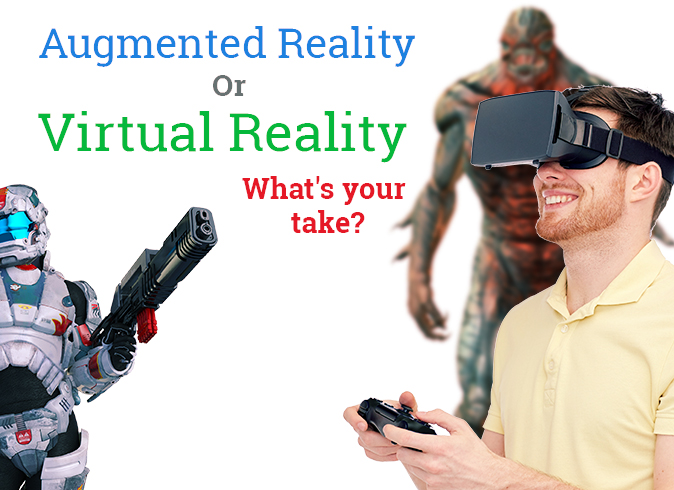<p style="text-align: justify;">With the progress in technology, the things that seemed impossible ten years back are now actually happening. At present, two breakthrough technologies are influencing the world and have left everyone around fascinated with the question to determine the future computing platform of the world from these two: Augmented Reality or Virtual Reality?</p>
<p style="text-align: justify;">However, the point to consider is that both AR and VR have led to a major change in the field of entertainment, gaming, communication, and industry. Let’s bring AR and VR differences into light:</p>
<h3 style="text-align: justify;"><strong>What is Augmented Reality (AR)?</strong></h3>
<p style="text-align: justify;">AR is the enhanced version of Virtual Reality (VR) where instead of engrossing users in computer generated environment, they are acquainted with the world where virtual components overlay on real world content. This has become possible with the inbuilt camera feature of the mobile device.</p>
<p style="text-align: justify;">Envision Pokemon Go, wherein AR technology is employed to depict characters, balls, and graphics on the device. AR has empowered users to interact with virtual content in the real world.</p>
<p style="text-align: justify;">The AR experience will substantially offer customized and mesmerizing experience in near-future for the tech-world.</p>
<h3 style="text-align: justify;"><strong>What is Virtual Reality (VR)?</strong></h3>
<p style="text-align: justify;">Contrary to AR, VR is responsible for creating a virtual world or a computer-generated environment that can be accessed by a VR headset whether it’s a phone or a desktop. However, a PC, as a matter of course, is more powerful and captivating due to its effective hardware.</p>
<p style="text-align: justify;">Unlike AR, VR facilitates users by letting them gain experience from the same physical location they are in. VR demands additional hardware and technology that are quite expensive.</p>
<p style="text-align: justify;">Virtual reality limits users&#8217; experience to exactly what they are involved in! The only way to come out from that virtual world is to take off the headsets.</p>
<h3 style="text-align: justify;"><strong>The differences &#8211; AR versus VR</strong></h3>
<p style="text-align: justify;">The comparison of AR and VR is indeterminate. The forthcoming benefits of AR and VR fluctuate greatly, especially in the tech-world.</p>
<p style="text-align: justify;">VR proves constructive for those who are unable to mark their physical presence at some event. The virtual headgear keeps them engaged and connected as they can watch the event live from their location.</p>
<p style="text-align: justify;">At the same time, AR brings opportunities for users to interact with presentations, and increase event app gamification.</p>
<p style="text-align: justify;">Illustrating the cost of both devices, AR can be operated by most of the modern devices with the assistance of proper software/app through the inbuilt camera. But, HoloLens and Google Glass fall in the category of expensive devices.</p>
<p style="text-align: justify;">On the other hand, VR technology requires VR headsets such as Vive and Rift, having an exorbitant price. Lower end mobile devices are cheap while high-end mobile devices are still somewhat not pocket-friendly.</p>
<p style="text-align: justify;">The obstacle is that in the case of VR, desktop headsets require a powerful desktop to operate and not all mobile phones are capable enough to use a mobile VR headset even if it’s Google Cardboard.</p>
<p style="text-align: justify;">However, consider the fact that both devices can be used in almost any application such as entertainment, health, finance, and education.</p>
<h3 style="text-align: justify;"><strong>Conclusion</strong></h3>
<p style="text-align: justify;">It is clear from the above points that the way things are now, AR has the upper hand against VR, and that might not be changing anytime soon.</p>
<p style="text-align: justify;">But at the end, it is the best thing to neglect the comparison since they tend to target different fields, such as health, finance, and entertainment; yet both have different ways of approaching them.</p>
<p style="text-align: justify;">Altogether, VR and AR are the faces of advanced technology. Who knows, in future, we get some device having <strong>Augmented Virtual Reality technology</strong>! Imagine people will be able to enjoy each other’s presence without the need to share same physical space!</p>
<p style="text-align: justify;">Technology has enough potential to bring a magical change across the world!</p>
<p style="text-align: justify;"><strong>About Author:</strong> Macy Jones is an app developer in one of the best Mobile App Development Company in Sydney. Apart from this She love writing and reading blogs related to App designing and development.</p>

Augmented Reality or Virtual Reality- What’s Your Take?
